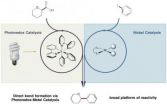(Press-News.org) Dietary restriction is one of the most-researched methods for slowing the aging process. Now, a new article published in The Journals of Gerontology, Series A: Biological Sciences and Medical Sciences helps explain the action of a drug that appears to mimic that method — rapamycin.
Rapamycin, an antibiotic and immunosuppressant approved for use about 15 years ago, has drawn extensive interest for its apparent ability — at least in laboratory animal tests — to emulate the ability of dietary restriction in helping animals to live both longer and healthier.
However, this medication has some drawbacks, including an increase in insulin resistance that could set the stage for diabetes. The new findings help to explain why that happens, and what could be done to address it.
They suggest that a combination of rapamycin and another drug to offset that increase in insulin resistance might provide the benefits of this medication without the unwanted side effect.
"This could be an important advance if it helps us find a way to gain the apparent benefits of rapamycin without increasing insulin resistance," said Viviana Perez, PhD, an author on the new article and an assistant professor in the Department of Biochemistry and Biophysics in the Oregon State University College of Science.
"It could provide a way not only to increase lifespan but to address some age-related diseases and improve general health," Perez said. "We might find a way for people not only to live longer, but to live better and with a higher quality of life."
Age-related diseases include many of the degenerative diseases that affect billions of people around the world and are among the leading causes of death: cardiovascular disease, diabetes, Alzheimer's disease and cancer.
Laboratory mice that have received rapamycin have reduced the age-dependent decline in spontaneous activity, demonstrated more fitness, improved cognition and cardiovascular health, had less cancer and lived substantially longer than mice fed a normal diet.
Rapamycin, first discovered from the soils of Easter Island, or Rapa Nui, in the South Pacific Ocean, is primarily used as an immunosuppressant to prevent rejection of organs and tissues. In recent years it was also observed that it can function as a metabolic "signaler" that inhibits a biological pathway found in almost all higher life forms — the ability to sense when food has been eaten, energy is available, and conditions are favorable for cell proliferation, protein synthesis, and growth to proceed.
Called mTOR in mammals, for the term "mammalian target of rapamycin," this pathway has a critical evolutionary value — it helps an organism avoid too much cellular expansion and growth when energy supplies are insufficient. That helps explain why some form of the pathway has been conserved across such a multitude of species, from yeast to fish to humans.
"Dietary restriction is one of the few interventions that inhibits this mTOR pathway," Perez said. "And a restricted diet in laboratory animals has been shown to increase their lifespan about 25 to 30 percent. Human groups who eat fewer calories, such as some Asian cultures, also live longer."
Aside from a food intake in laboratory mice that's about 40 percent fewer calories than normal, however, it's been found that another way to activate this pathway is with rapamycin, which appears to have a significant impact even when used late in life. Some human clinical trials are already underway exploring this potential.
A big drawback to long-term use of rapamycin, however, is the increase in insulin resistance, observed in both humans and laboratory animals. The new research identified why that is happening. It found that both dietary restriction and rapamycin inhibited lipid synthesis, but only dietary restriction increased the oxidation of those lipids in order to produce energy.
Rapamycin, by contrast, allowed a buildup of fatty acids and eventually an increase in insulin resistance, which in humans can lead to diabetes. However, the drug metformin can address that concern, and is already given to some diabetic patients to increase lipid oxidation. In lab tests, the combined use of rapamycin and metformin prevented the unwanted side effect.
"If proven true, then combined use of metformin and rapamycin for treating aging and age-associated diseases in humans may be possible," the researchers wrote in their conclusion.
This work was supported by the National Institutes of Health. Collaborators included researchers from Oklahoma University Health Science Center, the Oklahoma City VA Medical Center, University of Michigan-Flint, and South Texas Veterans Health Care System.
"There's still substantial work to do, and it may not be realistic to expect with humans what we have been able to accomplish with laboratory animals," Perez said. "People don't live in a cage and eat only the exact diet they are given. Nonetheless, the potential of this work is exciting."
INFORMATION:
The Journals of Gerontology, Series A: Biological Sciences and Medical Sciences is a peer-reviewed publication of The Gerontological Society of America (GSA), the nation's oldest and largest interdisciplinary organization devoted to research, education, and practice in the field of aging. The principal mission of the Society — and its 5,500+ members — is to advance the study of aging and disseminate information among scientists, decision makers, and the general public. GSA's structure also includes a policy institute, the National Academy on an Aging Society, and an educational branch, the Association for Gerontology in Higher Education
Research explains action of drug that may slow aging, related disease
2014-06-24
ELSE PRESS RELEASES FROM THIS DATE:
Hormones affect voting behavior, Nebraska researchers find
2014-06-24
OMAHA, Neb. – Researchers from the University of Nebraska at Omaha (UNO), the University of Nebraska-Lincoln (UNL) and Rice University have released a study that shows hormone levels can affect voter turnout.
As witnessed by recent voter turnout in primary elections, participation in U.S. national elections is low, relative to other western democracies. In fact, voter turnout in biennial national elections ranges includes only 40 to 60 percent of eligible voters.
The study, published June 22 in Physiology and Behavior, reports that while participation in electoral ...
A collaboration of minds and metal
2014-06-24
This past January, Derek Ahneman, a graduate student in the lab of Abigail Doyle, a Princeton University associate professor of chemistry, began work on an ambitious new project: he proposed the merger of two areas of research to enable a powerful reaction that neither could broadly achieve on its own.
One field, which is the Doyle research group's domain, was nickel catalysis, wherein nickel squeezes in and out of chemical bonds to bring molecules together. The other field was photoredox catalysis, which uses light to initiate a series of unique bond-breaking and bond-making ...
Researchers publish one of the longest longitudinal studies of cognition in MS
2014-06-24
Researchers at Kessler Foundation and the Cleveland Clinic have published one of the longest longitudinal studies of cognition in multiple sclerosis (MS). The article, "Cognitive impairment in multiple sclerosis: An 18-year follow-up study," (DOI: 10.1016/j.msard.2014.03.004) was epublished by Multiple Sclerosis and Related Disorders on April 13, 2014. Results provide insight into the natural evolution of cognitive changes over time, an important consideration for researchers and clinicians. Authors are Lauren B. Strober, PhD, of Kessler Foundation and Stephen M. Rao, ...
3-D printer for the world's largest delta?
2014-06-24
Boulder, Colo., USA - Three main rivers -- the Ganges, Brahmaputra, and Meghna -- meet in the Bengal basin to form the world's largest delta system, which serves as a gateway between the Himalayan mountains and the vast, deep-ocean Bengal Fan. This GSA BULLETIN paper by Stephen Goodbred and colleagues presents a new understanding of how this mega-delta, the Ganges-Brahmaputra-Meghna delta, came together over the past 10,000 years.
To determine the delta's construction during the Holocene, Goodbred and colleagues followed geochemical fingerprints to trace the paths and ...
NOAA GOES-R satellite black wing ready for flight
2014-06-24
The solar array that will provide power to NOAA's GOES-R satellite has been tested, approved and shipped to a facility where it will be incorporated on the spacecraft. The five sections of the solar array come together as one to resemble a giant black wing.
On May 13, 2014, the GOES-R satellite solar array panels were successful deployed in a Lockheed Martin clean room in Sunnyvale, California. The completed solar array was then delivered to Lockheed Martin's facility near Denver.
"The GOES-R solar array generates more than 4,000 watts of power, twice as much as that ...
Combo tumor imaging can distinguish malignant & benign breast tumors, help avoid biopsies
2014-06-24
PHILADELPHIA — Imaging breast tumors using four approaches together can better distinguish malignant breast tumors from those that are benign, compared with imaging using fewer approaches, and this may help avoid repeat breast biopsies, according to a study published in Clinical Cancer Research, a journal of the American Association for Cancer Research.
"By assessing many functional processes involved in cancer development, a multiparameter PET-MRI of the breast allows for a better differentiation of benign and malignant breast tumors than currently used DCE-MRI alone. ...
What millennials want
2014-06-24
Millennials, the generation after Generation X, born in the 1980s and 1990s, form their own demographic group, with their own unique tastes. According to a June 23rd panel at the 2014 Institute of Food Technologists (IFT) Annual Meeting & Food Expo® in New Orleans, industry must keep up with Millennials high-speed, digital-age expectations, if they're going to gain and keep them as customers.
"Millennials are food savvy and tech savvy," said Heidi Curry, Senior Manager Baker, Global Research and Development with Dunkin' Brands. "In addition, they're socially and environmentally ...
BMI measurement may be missing 25 percent of children who could be considered obese
2014-06-24
ROCHESTER, Minn. — Physicians using body mass index (BMI) to diagnose children as obese may be missing 25 percent of kids who have excess body fat despite a normal BMI, which can be a serious concern for long-term health, according to a Mayo Clinic study published online today in Pediatric Obesity.
The researchers found that BMI has high specificity in identifying pediatric obesity, meaning BMI accurately identifies children who are obese, but has a moderate sensitivity, meaning the BMI tool misses children who actually should be considered obese, according to the percent ...
Study suggests prayer can build unity in diverse organizations
2014-06-24
WASHINGTON, DC, June 24, 2014 — As the United States grows more diverse than ever, organizations from Fortune 500 companies to political parties are scrambling to keep pace. But in doing so, they face the challenge of uniting people from very different backgrounds in a single purpose.
A new study led by a University of Connecticut sociologist suggests that if they want to succeed, they could learn a lot from how an unlikely practice — prayer — is used in one set of diverse organizations.
Specifically, the study finds that interfaith group prayer serves as a "bridging ...
UF part of research team that finds equine influenza virus in camels
2014-06-24
GAINESVILLE, Fla. --- University of Florida researchers have found evidence that an influenza A virus can jump from horses to camels – and humans could be next.
The One Health Center of Excellence for Research and Training in UF's Emerging Pathogens Institute, in collaboration with U.S. and Mongolian institutions, has identified the first known case of an equine influenza virus in camels. Their findings will be published in the December issue of Emerging Infectious Diseases, but an ahead of print version of the report is available here:
http://wwwnc.cdc.gov/eid/article/20/12/14-0435_article
"Over ...


